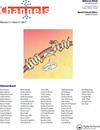癫痫发作后HCN通道介导的Ih电流缺失导致运动功能障碍
IF 3.2
3区 生物学
Q2 BIOCHEMISTRY & MOLECULAR BIOLOGY
引用次数: 2
摘要
超极化激活的环核苷酸门控(HCN)通道突变与以反复发作(癫痫)为特征的疾病有关,在其他典型的大脑中,也观察到诱发性癫痫发作后HCN通道功能障碍。尽管大量的研究表明HCN通道是神经元兴奋性的关键调节因子,但HCN通道是否与癫痫相关的行为合并症有关仍受到有限的关注。最近一篇由我们共同撰写的文章提供了证据,证明实验性癫痫发作会破坏HCN通道功能,这种类型的破坏会导致熟练运动行为的长期损害。鉴于在实验性癫痫发作和临床癫痫发作后观察到间期运动障碍,这项新研究表明,HCN通道可能是治疗这种疾病合并症的新治疗靶点。HCN频道对大脑兴奋性有多种贡献。在单个神经元水平上,由HCN通道介导的电流,包括Ih在内的许多名称,影响突触输入的整合以及动作电位放电的模式。先前的研究表明,HCN通道是限制内嗅皮层空间放电场的一种机制。HCN通道也限制海马依赖的空间记忆。在我们最近的工作中,我们试图检查HCN通道在运动皮层网络中的作用。该研究使用3种不同的方法操纵HCN频道。反复的实验性癫痫发作降低了构成皮质脊髓束的第5层锥体细胞的Ih。药物阻滞剂ZD7288局部应用于运动皮质,HCN1基因敲除(HCN1)小鼠作为遗传策略。为了检查运动皮层的网络功能,在体内研究使用标准皮质内微刺激(ICMS)来系统地测量新皮层内不同部位引起的前肢运动反应。在短训练ICMS参数下,对运动皮质内单个部位的刺激主要导致身体对侧的反应,其特征是通过单个关节进行简单的屈曲或伸展。反复发作时,表现出复杂前肢运动反应的刺激位点数量显著增加,而不是简单的屈伸运动。这些新的复杂前肢反应是简单运动反应的组合,并出现在刺激的对侧,通常是双侧。直接应用ZD7228和HCN1小鼠也可观察到这一结果。此外,在HCN1小鼠中测试ZD7228的作用时,ICMS反应没有进一步变化。由于先前的实验表明实验性癫痫发作会损害熟练的运动行为,因此进一步的实验测试了基因或药物操作HCN通道是否也会影响清醒行为的啮齿动物的熟练运动行为。HCN1小鼠在熟练的前肢伸展任务中表现出表现下降和非典型运动。Na€ıve老鼠局部注射本文章由计算机程序翻译,如有差异,请以英文原文为准。
Loss of HCN channel mediated Ih current following seizures accounts for movement dysfunction
Hyperpolarisation-activated, cyclic nucleotide-gated (HCN) channel mutations are linked to disorders characterized by the occurrence of recurrent seizures (epilepsies) and HCN channel dysfunction has also been observed following evoked seizures in otherwise typical brains. Whether HCN channels contribute to the behavioral co-morbidities associated with epilepsy has received limited attention, despite extensive work to show that they serve as key regulators of neuronal excitability. A recent article, co-authored by us, provides evidence that experimental seizures disrupt HCN channel function and that this type of disruption leads to long-term impairments in skilled motor behavior. Given that interictal motor impairments are observed following experimental seizures and clinical epilepsy, this new study suggests an intriguing possibility that HCN channels represent a novel therapeutic target to treat co-morbidities of this disorder. HCN channels provide a diverse set of contributions to brain excitability. At the level of individual neurons, the current mediated by HCN channels, referred to by many names including Ih, affects integration of synaptic input as well as patterns of action potential firing. It has previously been shown that HCN channels serve as a mechanism to restrict spatial firing fields within entorhinal cortex. HCN channels also restrict hippocampal-dependent spatial memory. In our recent work, we sought to examine the role of HCN channels for networks located in motor cortex. The study manipulated HCN channels using 3 separate approaches. Repeated experimental seizures were used as they reduce Ih in layer 5 pyramidal cells that make up the cortical spinal tract. The pharmacological blocker ZD7288 was locally applied within motor cortex and global HCN1 knockout (HCN1) mice were used as a genetic strategy. In order to examine network function of motor cortex, in vivo studies were performed using standard intracortical microstimulation (ICMS) to systematically measure evoked forelimb movement responses across sites within neocortex. With short-train ICMS parameters, stimulation at individual sites within motor cortex predominantly results in responses on the contralateral side of the body that are characterized by simple flexion or extension across a single joint. With repeated seizures there was a substantial increase in the number of stimulation sites that exhibited complex forelimb movement responses rather than the simple flexion or extension movements. These new complex forelimb responses occurred as combinations of simple movement responses and were present contralateral to stimulation and often bilaterally. This result was also seen after direct application of ZD7228 and in HCN1 mice. Additionally, no further change in ICMS responses occurred when the effects of ZD7228 were tested in HCN1 mice. Since experimental seizures had previously been shown to impair skilled motor behavior, additional experiments tested whether genetic or pharmacological manipulation of HCN channels also affected skilled motor behavior in awake behaving rodents. HCN1 mice exhibited decreased performance and atypical movements on a skilled forelimb-reaching task. Na€ıve rats given local
求助全文
通过发布文献求助,成功后即可免费获取论文全文。
去求助
来源期刊

Channels
生物-生化与分子生物学
CiteScore
5.90
自引率
0.00%
发文量
21
审稿时长
6-12 weeks
期刊介绍:
Channels is an open access journal for all aspects of ion channel research. The journal publishes high quality papers that shed new light on ion channel and ion transporter/exchanger function, structure, biophysics, pharmacology, and regulation in health and disease.
Channels welcomes interdisciplinary approaches that address ion channel physiology in areas such as neuroscience, cardiovascular sciences, cancer research, endocrinology, and gastroenterology. Our aim is to foster communication among the ion channel and transporter communities and facilitate the advancement of the field.
 求助内容:
求助内容: 应助结果提醒方式:
应助结果提醒方式:


